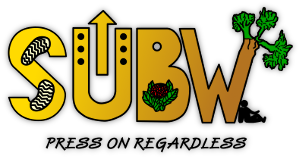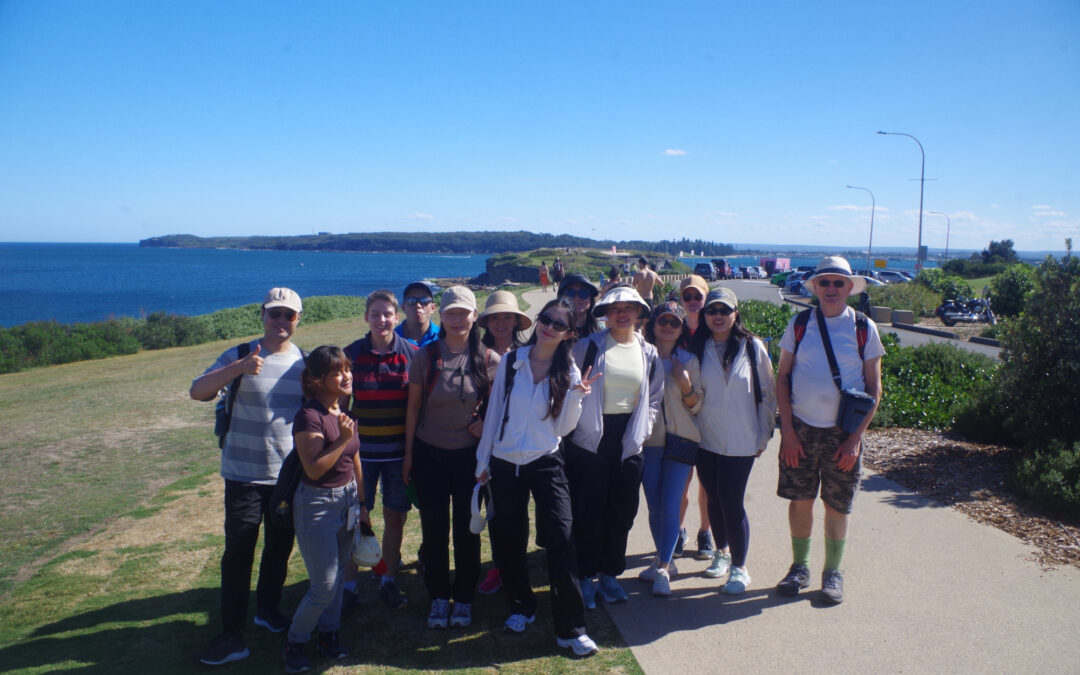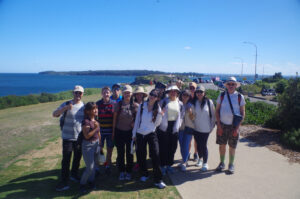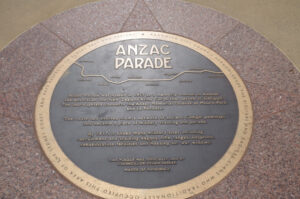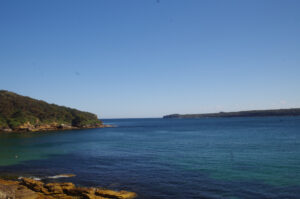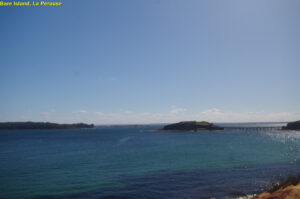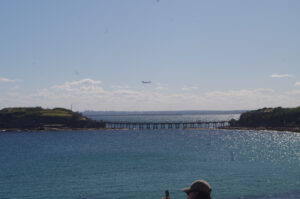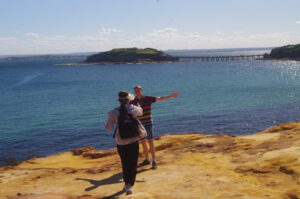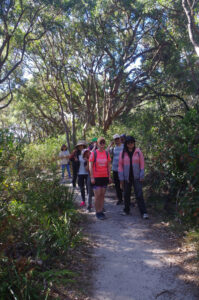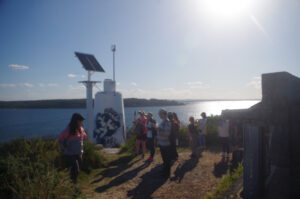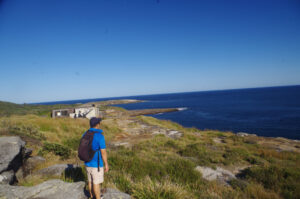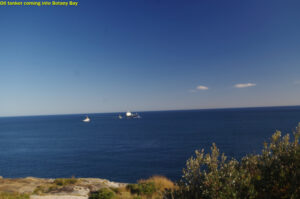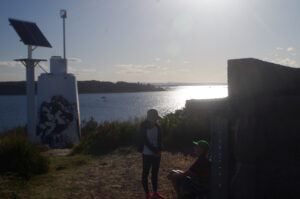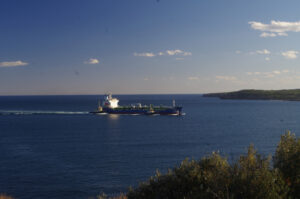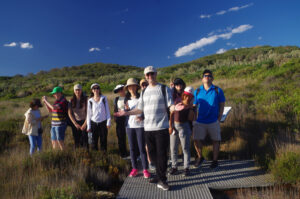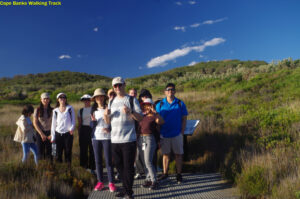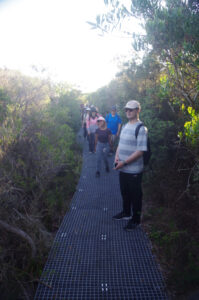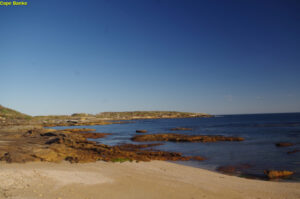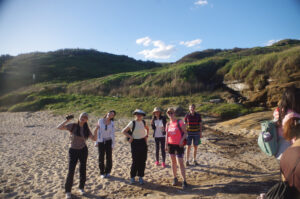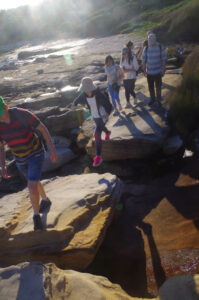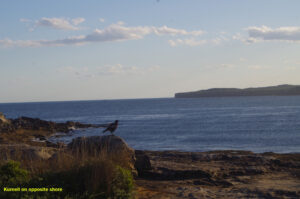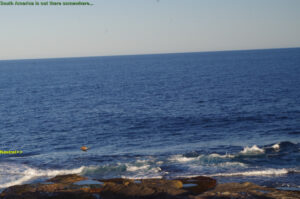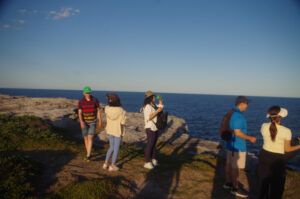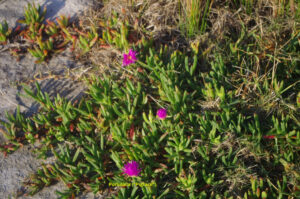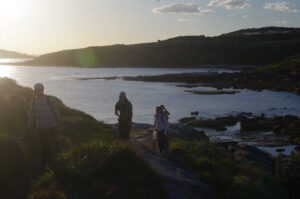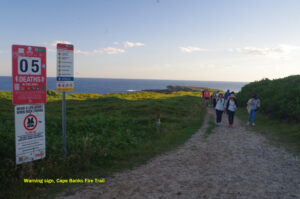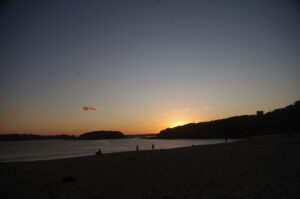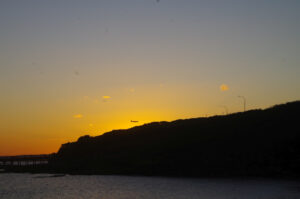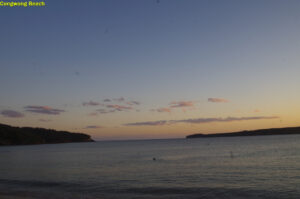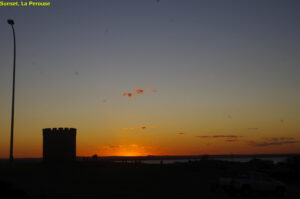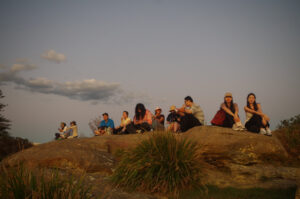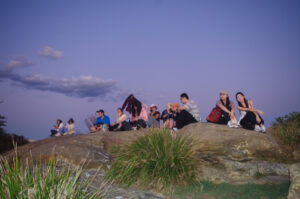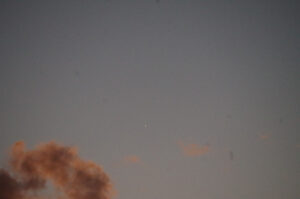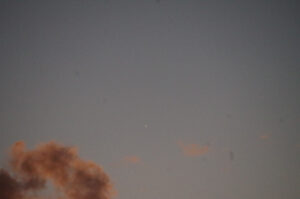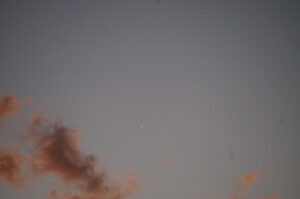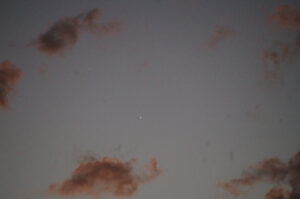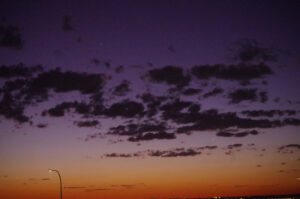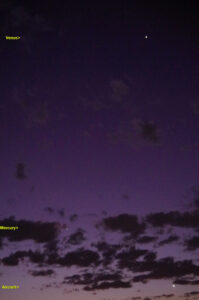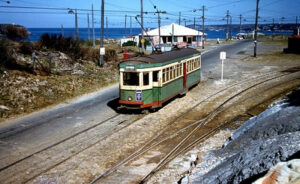Date: 8/11/2024
Trip leader: Bruce Stafford
Party: Bicheng, Carrie, Cornelia, Fredo, Katharina, Lei, Lin, Pingkan, Yufei, Yuning, Zijing, Zijing’s Mum Jingaihua (guest).
Afternoon walk in Kamay NP La Perouse, and we did see Mercury, Fri 8/11/2024.
There was a good turnout for a friday afternoon walk during exam time; maybe examiners tend to avoid friday afternoon exams! There were a couple of minor transport glitches but mostly everything was sorted out okay. And best of all, my gamble of picking the right day with a clear sky to see the planet Mercury paid off, as you will see later.
Several of us met up at the tram stop (“light rail” stop) at Central’s Chalmers Street, and found that the trams were running 5 minutes late and out of order. That meant that although we could have got on earlier trams, we had to wait as far as 2.49pm which is when our tram was supposed to depart, so that no one would be left behind. The time spent waiting at Central was used to get Zijing’s mum to read and sign her trip waiver form. As it turned out, we ended up on the same connecting bus at Kingsford Junoirs anyway. The change-over to the La Perouse bus at Kingsford Juniors gave an immediate example of how superior the tram trip was, including the boarding process, compared to buses. As usual everyone had to get on the front door of the bus to swipe their cards, slowing down the boarding, and then came the often jerky bumping ride on the bus as it struggled through the afternoon school pickup traffic on Anzac Parade. I pointed out to the others how fast and smooth the trip would have been if trams were still using the wide rail reservation which is still down the middle of Anzac Parade clear of traffic, as they did until 1961. I will mention more about this at the end.
So, after arriving at La Perouse a little late, we met up with Bicheno who drove there, and Carrie who was the bus ahead of us. After a toilet stop, we then all posed for a group photo taken by a tourist who kindly took the pic so that I could be included in it. Then we set off on our walk.
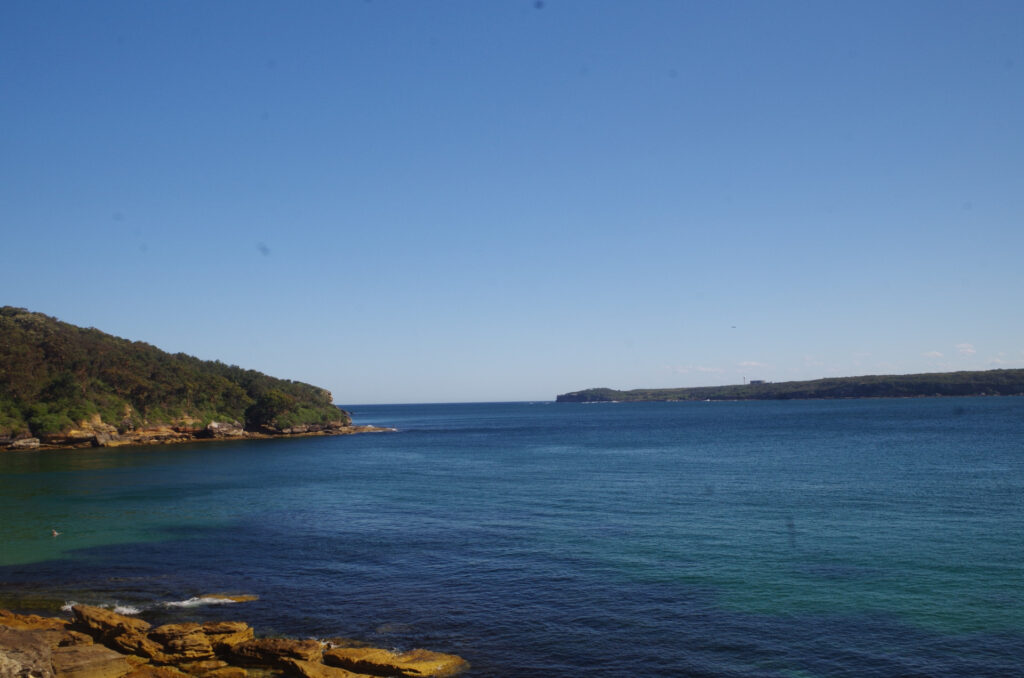
First part of the walk took us across Congwong Beach, a pleasant spot with a few people in swimming on this rather warm day. The sky was a steely blue colour and almost totally clear of clouds, which indicated that we would have a clear sky for planet viewing later on. We took a detour 250 metres along the short Congwong Walking Track (which is a dead end) to take in some views, and then back-tracked to the Beach to join the “Congwong Beach Trail” (which as the name suggests, doubles as a fire trail), and then a right turn onto “Henry Head Walking Track”, which goes for a fair distance through a mixture of heath and coastal open forest. It comes to a junction with “Brown’s Rock Walking Track, which goes downhill for 800 metres until reaching Brown’s Rock, which is just a fishing spot, although with nice views to Kurnell on the other side of Botany Bay. Here we saw a dragon (Eastern Water Dragon) which was camera shy and hid in the thickets making it difficult to photograph, Cornelia noticed some remnants of fishing lines tanged in the undergrowth which can be an environmental hazard for small birds and animals, and for sea creatures if washed into the water. We collected quite a bit of this fishing line and deposited it safely in garbage bins there.
After doing this tidying up we returned back uphill to the Henry Head Walking Track to Henry Head Lighthouse, which is only a small structure with a red navigational light. Nearby are some decaying old fortifications from World War 2 probably hurredly constructed once Japan entered the War after Pearl Harbour. Up till then, Australia’s coastal defences were almost non-existent, and we discussed how German ships were able to follow the coastline through Bass Strait and New South Wales unchallenged; they laid mines in Bass Strait and also along the Central Coast between Palm Beach and Newcastle. It was only after the Japanese scare in 1942 that the crumbling concrete blockhouses that are here and at other places around Sydney and Newcastle were hurredly constructed, and are now deteriorating after decades of exposure to the corrosive sea air. There are signs on many warning that they are unsafe to enter. There are also some remains of an older late 19th Century post that was there until 1910 but we didn’t get a close look at it.
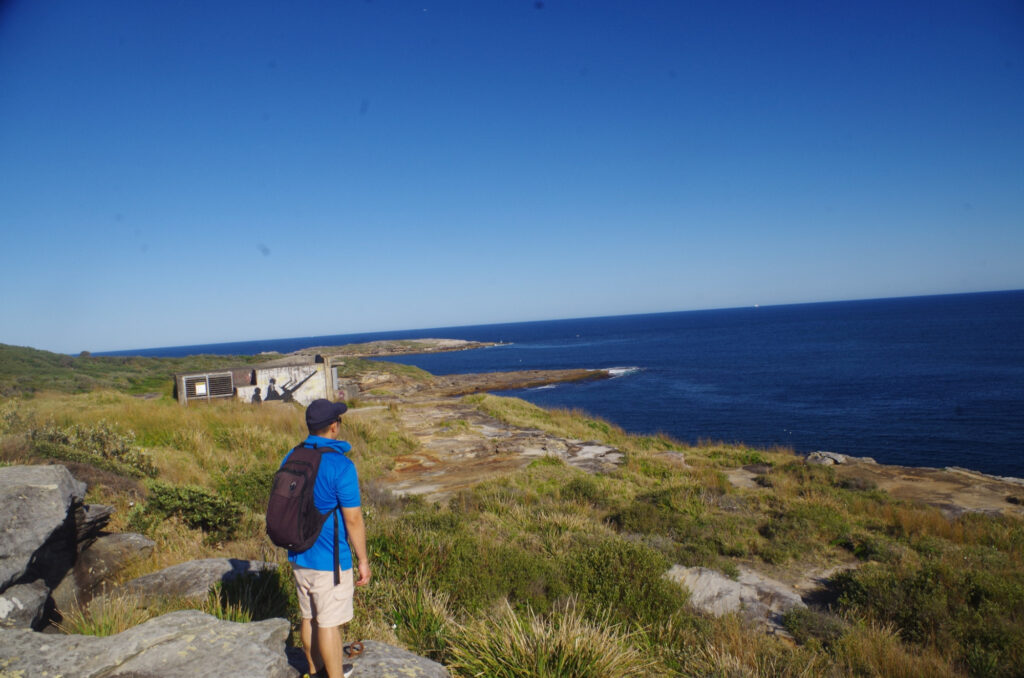
We had a break here enjoying the view which included a tanker coming through the heads of Botany Bay and being met by two tugboats to guide it in. Some of our group who would be returning to China after the end of the year posed for selfies with me!
Then we resumed our walk and continued on to Cape Banks via Cape Banks Walking Track and Cruwee Cove Beach. This track passes through heath and across a few hanging swamps via boardwalks. We saw several Skinks along the way and lots of white butterflies (which disappeared into the undergrowth too fast to be photographed), and on arrival at Cruwee Cove Beach a Black Snake quickly fled for cover underneath a fallen concrete post beside the track. On the beach itself were a few dead Short-tailed Shearwaters, a sea bird which in the Australian Autumn/Fall fly across the Pacific Ocean and on to the Bering Sea between Russia and Alaska to spend the Australian winter there. Then they return via California to fly directly from there across the Pacific Ocean to breed on Australia’s east coast between Newcastle and Tasmania in our Summer. Such a long migration takes a toll on many birds and it’s sadly common to see dead or dying Shearwaters on our beaches around this time of year.
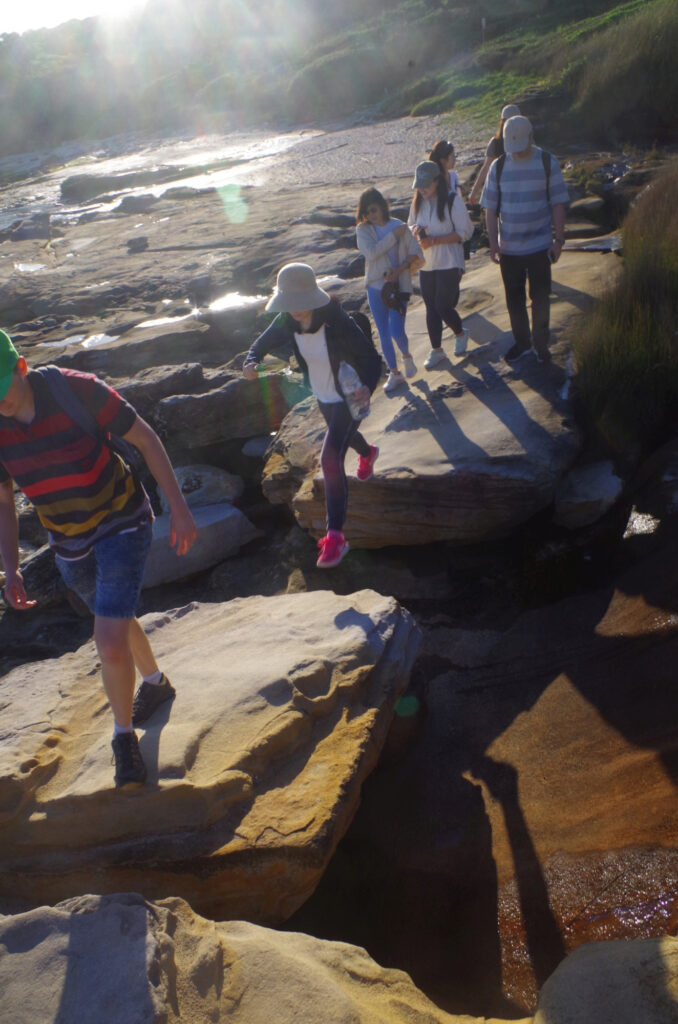
There was a bit of rockhapping along this section of track, and we suddenly came to places where the track intersected with some paths for golfers! There were signs asking walkers to give way to golfers if there were any (none there today). Then the track headed south to Cape Banks which is the north headland of Botany Bay. It’s an interesting and lonely windswept spot and has the same pure white sandstone seen in the Royal National Park along the coast south of Bundeena. After looking around there we returned back to the junction of the Cape Banks Walking Track with the Cape Banks Fire Trail. This trail follows the coastline, and at one place there is a warning sign about the dangers of rock fishing along this part of the Coast. See the photo of the warning sign with its grim statistic of 5 deaths here in recent years. From there the trail turns inland until reaching the base of the Westpac Life Saver Helicopter Base, then along Cape Banks Road which is a bitumen narrow road (watching out for vehicles). This goes for about 1.7km and passes through the middle of a golf course, although that is not obvious. Maybe need to watch out for stray golf balls sometimes!
Just before we came to Henry Head Lane, we took a track which goes right for a shortcut, and a couple of people took advantage of the thick scrub cover for a brief toilet stop! Then the track crossed Henry Head Lane and continued through open coastal forest to reach the Congwong Beach Fire Trail and then back to Congwong Beach near where we had started our walk. The timing was perfect as we arrived just as the sun was setting in the west behind La Perouse and Bare Island, giving many in our group a great photo opportunity. Then it was just a short track off the beach to Anzac Parade. Here we had a break with Katharina giving out welcome slices of rock melon.
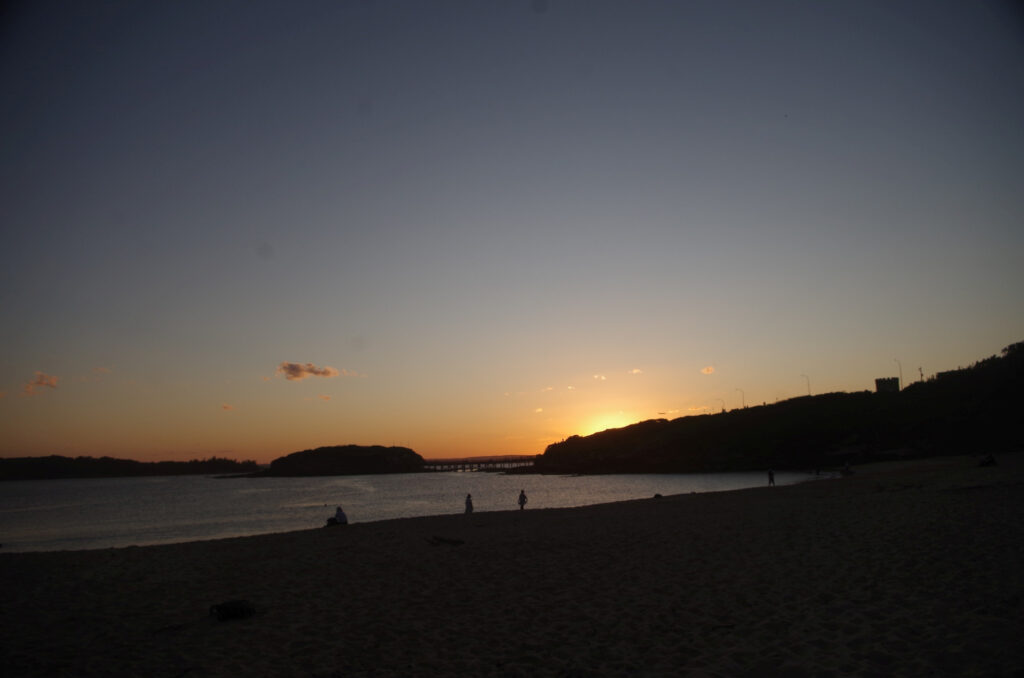
La Perouse was surprisingly busy with a traffic jam forming along the loop of Anzac Parade around the Macquarie watchtower and the picnic area. As far as I knew there was no special event here; maybe they were just like us, coming to watch the brilliant sunset over Botany Bay. Anyway we made our way to a handy rock ledge with a clear uninterrupted view of Botany Bay, and waited for the sky to darken. Meanwhile we shared snacks.
This was one of the highlights of this walk: a chance to see the elusive planet Mercury. As explained in the walk description, Mercury can be very difficult or impossible to see in the Northern Hemisphere (north of Raleigh NC anyway!). Copernicus, who in 1533 proposed a Sun-centrered solar system, never saw it in his life time because he lived in Poland. One problem for people who live closer to the polar regions compared to Sydney is the much longer twilight period there, so that the sky doesn’t get dark fast enough to see Mercury before it sets. Some students from northern Europe have in the past commented how it gets dark “super quick” after sunset in Australia. Therefore people who live in the U.K., Germany, and China north of Zhengzhou, Henan, will have great difficulty seeing it, even on an ideal evening like July 4 next year.
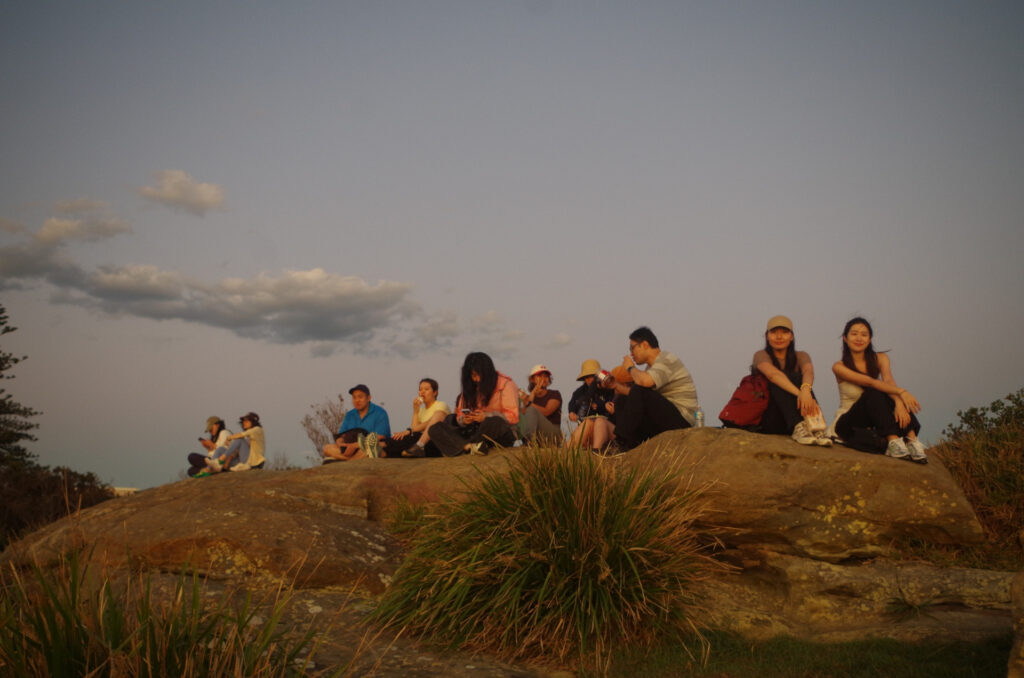
So we waited, and Venus was the first to show up around 7.45pm, and then not too long after that I spotted Mercury with binoculars, and soon it was a tiny naked-eye object. Worringly, some light clouds had appeared near where it was, but they turned out to be a blessing in disguise. I could tell people “It’s located just to the right of that small cloud”. I took a couple of photos with a 200mm lens on manual focus (semi-auto cameras can have problems focusing on an object 170 million km away!). If you have a look at my photos and enlarge them you will see that the planet is slightly crescent-shaped (as is Venus) because it has phases like the moon, being so close to the sun. This is one way of distinguishing it from a star, which will always be a simple point of light.
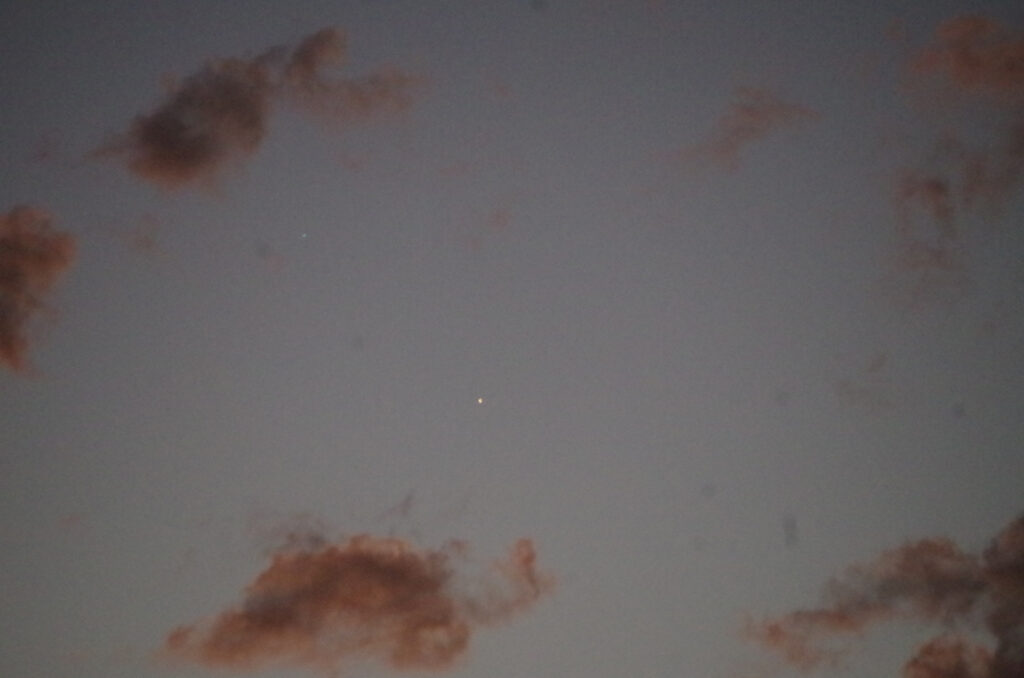
We packed up around 8.15pm to get the 8.23pm bus back to Kingsford Juniors and then the tram to the City. Everyone seems to enjoy the day and achieved our objective of seeing Mercury. On the way back we discussed the Pinyin System (showing Chinese words in the latin alphabet), and how the election in the U.S. of Number 47 might affect our economies; it’s not just Chinese products that No.47 will put large tariffs on, it’s Australian and German exports to the U.S. as well.
La Perouse was named after the French explorer Jean-Francois de Galaup, comte de Laperouse (how’s that for a name), who came to Botany Bay in 1788. His expedition disappeared later that year from shipwreck. A French Catholic priest in his expedition, Claude-Francois Joseph Louis Receveur, died at Botany Bay and his grave overlooks Frenchman’s Bay in the park within the Anzac Parade Loop. He was the second non-indigenous person to be buried in Australia.
La Perouse is also a very significant name in NSW transport history, being to where the last tram in Sydney ran when the whole tram system was finally closed in Februiary 1961. (I told Katharine how the propaganda of the transport bureaucrats said that the last tram at La Perouse “had been replaced by a shiny new double decker bus”. In their usual incompetence, the transport bureaucrats didn’t notice that the “new” double decker bus was actually older than the tram it replaced!). The removal of Sydney’s first trams is regarded as one of the worst ever Australian transport sins. A Labor government was in power at the time and even today NSW Labor is still strongly resistant to expanding trams in Sydney. I am no fan of the Liberal Party but at least their governments did succeed in bringing back trams to Sydney – even if disguised as “light rail”. The last photo shows La Perouse in the last weeks of the tram service.
Kamay National Park was new to me so it was an interesting exploratory walk, and there’s plenty more interesting things to be seen there if there’s extra time available.
Final point: there will be an excellent pre-dawn sighting not only of Mercury but also of Venus, Saturn and a waning moon all in a close group on April 25 next year (which will also be the ANZAC Day long weekend). You need to be up before 6am to see it though. Maybe a camping trip can be organised somewhere – and hope for a nice clear day.
One person withdrew because of illness, but there were no actual “no shows”.
Bruce Stafford.
Some links:
Shearwaters: https://www2.environment.nsw.gov.au/topics/animals-and-plants/native-animals/native-animal-facts/birds/shearwaters
https://www.wires.org.au/seasonal-animal-advice/migrating-seabirds
Night sky map (insert name of your nearest city): https://www.timeanddate.com/astronomy/night/australia/sydney
“Last Tram to La Perouse (1961)” ABC Archives (You tube) https://www.youtube.com/watch?v=GUnRoU81XWI
